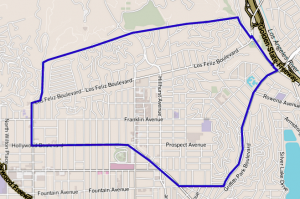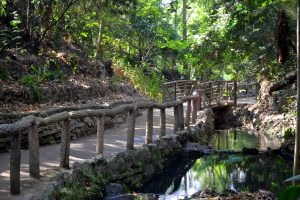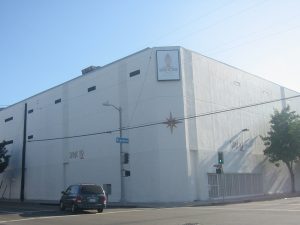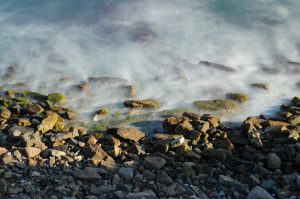My Los Angeles has been eaten by time. It existed from spring 1991 to late fall 1993 and now lives on only in my body, where I store the lessons L.A. taught me — mostly lessons about who I wasn’t and who I’d never be. I’m grateful to L.A. for clarifying these truths, though at first I felt angry for the rebuke. If L.A. wouldn’t tell me the truth, who would have?
Los Feliz — It was mine before it was hip and expensive. At one point I rented a room two blocks north of the House of Pies for $275. My mecca was the Onyx Cafe on North Vermont between Prospect and Franklin, where I lived out my Charles Bukowski–wannabe fantasies sloshed on wine before open mics. The Onyx had a great underground poetry scene frequented by S.A. Griffin, Rafael F.J. Alvarado, and Eric Brown — who taught me more about the long, breath-centered line than anyone not named Whitman or Ginsberg.
I never became more than a hanger-on at the Onyx, but it was a perfect home for a guy with an MFA in Screenwriting who knew, almost the moment he arrived in L.A., that he didn’t have what it took to make it in the business. The Onyx reaffirmed my belief that the purity of my creative heart was more important than making bucks, which I really needed because I was failing at the latter.
Through the Onyx I did things elsewhere in L.A. that I’ll remember. Wild parties at 1428 Nadeau Drive. A ride on the blue line train to Long Beach with a dozen other poets, all of us reading aloud to the passengers. An L.A. Cacophony Society pageant at a warehouse deep downtown to celebrate the end of the Year of the Monkey. Los Feliz didn’t look wild the last time I saw it a decade ago and probably doesn’t look wild now, but I had my last wild time there.

Map of Los Feliz from The Los Angeles Times, via Wikimedia Commons.
Griffith Park — I hadn’t known anything about Los Feliz, not even the Onyx, when I picked it as my L.A. home. But it had a big patch of green next to it on the map, and that’s what mattered. A Colorado kid at heart, I loved hiking without a destination and getting lost. The first real artist I knew, the experimental filmmaker Ken Jacobs, would tell his students to “Get lost!” and bring a camera with us.
In Griffith Park I got lost in the physical universe and in the melancholy of my mind, which still reverberated with the empty cries of a lost childhood. I’d walk up the Los Feliz streets that abutted the park, Catalina and Bonvue and Glendower, searching for secret entrances. Once inside I’d take the first reasonable vertical until I couldn’t climb anymore, then bushwhack down. Brambles cut my arms. I saw coyotes. I slid down a rock scree knowing that if I died there, it would take days for people to find me.
On the way down I’d often wind up near the Riverside Drive entrance, within earshot of the 5, and watch the kids ride ponies. Sometimes I’d come down the other direction by Ferndell Nature Trail and watch families picnicking. Why did I always stare at kids and families? Griffith Park, an emptiness inside an overfull city, gave me answers without words.

Photo by Amatullah Guyot, via Wikimedia Commons.
Sunset Gower Studios (I think) — I couldn’t sell my scripts, couldn’t get a writing room gig in TV, wasn’t making it by any calculation. I took production jobs to stay in the business, including one as an odd-job P.A. for the Comedy Central series Comics Only. I worked the dolly, took pictures when the set photographer was gone, even acted as an extra in some sketches. Somewhere in space, a few clips of me are bouncing around.
I screwed up my biggest job: driving a flatbed truck carrying a small crane up the 101 and down into North Hollywood. It was a big-ass truck with a 20-foot bed, and I felt macho as the gate man let me onto the streets. I heard a thunk but didn’t think much of it. I completed my delivery and called for my ride back and learned that I’d knocked the sliding security gate off its hinges. A thousand dollars worth of damage, traffic screwed-up all day, everybody cursing the idiot who did it.
Amazingly I didn’t get fired, but everybody knew I was going nowhere. I was wasting my time in L.A. because it had told me, with the finality of an almost-silent crash, that I didn’t belong.

Photo by Gary Minnaert, via Wikimedia Commons.
Point Mugu — It’s not L.A., you’ll say, and I’ll give you that because it’s closer to Oxnard. But until you pass Mugu Rock and head up the PCH, you’re in L.A.’s psycho-spiritual orbit. The beach had a different vibe than the ones in Malibu, and I loved the un-coolness of it. Fishermen sat on beach chairs with three or four poles stuck in the sand, waiting for their prey to bite. Long-distance travelers took naps with the sliding doors of their vans wide open. Surfers read their fortunes on the waves. It didn’t feel performative at all — just my speed.
Going to Point Mugu was one of the last things I did in L.A. I’d earned $100 for a day of inventorying VHS tapes at Roger Corman’s production company and immediately went to a pawn shop to buy the junky 1955 Reynolds trombone I’d been ogling. I never learned how to make notes on it. I just wanted to blow, and I did. I knew one day, when it was time to leave L.A., I’d take that horn to Point Mugu.
In late fall of 1993 I went there and played the living hell out of that trombone, trying to blow louder than the sea and not caring that it fought back, drenching me and my new brass weapon in the battle against despair. I played until I ran out of breath, then drove back to Los Feliz knowing that the Hollywood dream had passed out of me, transformed into trombone blares on the sea-sprayed air at Point Mugu.
L.A. had told me the truth, and with a horn I didn’t know how to play, I told it the truth back. Then we were square, and it was time for me to go. To take the memories in my brain and body and go.

Photo by King of Hearts, via Wikimedia Commons.
¤
Steven Wingate’s books include the novel Of Fathers and Fire, published in April 2019 by the University of Nebraska Press as part of its Flyover Fiction series, and the short story collection Wifeshopping, which won the Bakeless Prize in Fiction from Bread Loaf Writers' Conference. His interactive media projects have been exhibited in Singapore, Hong Kong, Norway, Canada, and the United Kingdom. He is an associate professor at South Dakota State University and associate editor at Fiction Writers Review. Visit stevenwingate.com.
LARB Contributor
Did you know LARB is a reader-supported nonprofit?
LARB publishes daily without a paywall as part of our mission to make rigorous, incisive, and engaging writing on every aspect of literature, culture, and the arts freely accessible to the public. Help us continue this work with your tax-deductible donation today!
:quality(75)/https%3A%2F%2Fdev.lareviewofbooks.org%2Fwp-content%2Fuploads%2F2019%2F02%2FPoint_Mugu_September_2013_005.jpg)